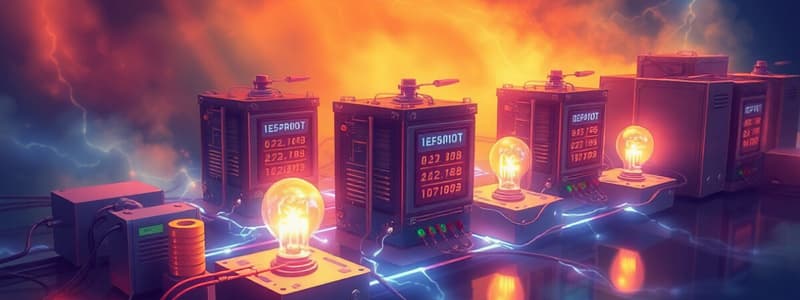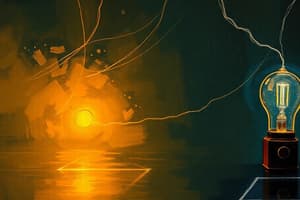Podcast
Questions and Answers
What is the primary function of a rectifier?
What is the primary function of a rectifier?
To convert alternating current (AC) supply into unidirectional direct current (DC) supply.
Describe the function of a diode in a half wave rectifier.
Describe the function of a diode in a half wave rectifier.
The diode allows current to flow during the positive half of the AC cycle and blocks it during the negative half.
What is a significant disadvantage of using a half wave rectifier?
What is a significant disadvantage of using a half wave rectifier?
It has a high ripple factor, leading to less steady DC output and a low rectification efficiency.
Explain how a full wave center-tapped rectifier differs from a half wave rectifier.
Explain how a full wave center-tapped rectifier differs from a half wave rectifier.
What is the primary advantage of using a full wave bridge rectifier?
What is the primary advantage of using a full wave bridge rectifier?
Why is a transformer utilization factor (TUF) low in a half wave rectifier?
Why is a transformer utilization factor (TUF) low in a half wave rectifier?
What happens during the negative half of the AC input in a full wave center-tapped rectifier?
What happens during the negative half of the AC input in a full wave center-tapped rectifier?
Highlight a major consequence of the high ripple content produced by a half wave rectifier.
Highlight a major consequence of the high ripple content produced by a half wave rectifier.
What occurs to the diodes in a bridge rectifier during the positive half of the AC cycle?
What occurs to the diodes in a bridge rectifier during the positive half of the AC cycle?
Explain one major advantage of using a bridge rectifier over a half-wave rectifier.
Explain one major advantage of using a bridge rectifier over a half-wave rectifier.
What is the impact of using a bridge rectifier on the ripple voltage in comparison to a half-wave rectifier?
What is the impact of using a bridge rectifier on the ripple voltage in comparison to a half-wave rectifier?
What disadvantage arises from the necessity of four diodes in a bridge rectifier?
What disadvantage arises from the necessity of four diodes in a bridge rectifier?
How does the transformer requirement differ when using a bridge rectifier compared to other rectifying methods?
How does the transformer requirement differ when using a bridge rectifier compared to other rectifying methods?
Flashcards
Bridge Rectifier: Positive Half Cycle
Bridge Rectifier: Positive Half Cycle
In a bridge rectifier during the positive half cycle of the input AC, diodes D1 and D2 are forward biased, allowing current to flow through them to the load.
Bridge Rectifier: Negative Half Cycle
Bridge Rectifier: Negative Half Cycle
During the negative half cycle of the input AC, diodes D3 and D4 are forward biased, allowing current to flow through them to the load.
Bridge Rectifier: Rectification Efficiency
Bridge Rectifier: Rectification Efficiency
A bridge rectifier has twice the rectification efficiency of a half-wave rectifier, resulting in a higher output voltage and power, as well as a higher transformer utilization factor.
Bridge Rectifier: Output Ripple
Bridge Rectifier: Output Ripple
Signup and view all the flashcards
Bridge Rectifier: Transformer
Bridge Rectifier: Transformer
Signup and view all the flashcards
What is a rectifier?
What is a rectifier?
Signup and view all the flashcards
What is rectification?
What is rectification?
Signup and view all the flashcards
What is a half-wave rectifier?
What is a half-wave rectifier?
Signup and view all the flashcards
What is a full-wave center-tapped rectifier?
What is a full-wave center-tapped rectifier?
Signup and view all the flashcards
What is a full-wave bridge rectifier?
What is a full-wave bridge rectifier?
Signup and view all the flashcards
What is ripple?
What is ripple?
Signup and view all the flashcards
What is ripple factor?
What is ripple factor?
Signup and view all the flashcards
What is rectification efficiency?
What is rectification efficiency?
Signup and view all the flashcards
Study Notes
Rectifiers
- A rectifier is an electrical device that converts alternating current (AC) to unidirectional direct current (DC) supply.
- This process is also called rectification.
- Bridge rectifiers are available in various packages (modules) ranging from a few amperes to several hundred amperes.
- Semiconductor diodes are commonly used in bridge rectifier circuits for converting AC to DC, as they allow current flow in only one direction (unidirectional).
Types of Rectifiers
- Rectifiers are categorized into single-phase and three-phase types.
- Each category further branches into uncontrolled and controlled rectifiers.
- Controlled rectifiers have additional components to control the timing of current flow.
- Subcategories include half-wave, full-wave, bridge, and split-supply rectifiers. These varying configurations lead to distinct output characteristics.
Half-Wave Rectifier
- A simple rectifier utilizing a single diode connected in series with a load.
- Commonly used for low-power applications.
- During the positive half-cycle of the AC input, the diode becomes forward-biased, allowing current flow.
- During the negative half-cycle, the diode becomes reverse-biased, blocking current flow.
- This type suffers from high ripple content in the output and is less suitable for pure resistive loads.
Full-Wave Center-Tapped Rectifier
- This rectifier employs two diodes and a transformer with a center-tapped secondary winding.
- During the positive half-cycle, diode D1 conducts, and current flows through the load.
- During the negative half, diode D2 conducts, continuing current flow in the same direction through the load.
- The current flow through the load remains the same even when the voltage polarity changes, unlike in a half-wave rectifier.
Full-Wave Bridge Rectifier
- Using the same secondary voltage, this rectifier produces almost double the output voltage compared to a full-wave center-tapped configuration.
- During the positive half-cycle, diodes D1 and D2 conduct, and during the negative half-cycle, diodes D3 and D4 conduct, resulting in continuous current flow through the load.
- This configuration doesn't require a center-tapped transformer, simplifying the circuit.
Rectifier Efficiency
- Efficiency (η) measures the percentage of input AC power converted to useful DC output power.
- Typical efficiency for a half-wave rectifier is lower than that of a full-wave rectifier due to the presence of ripple voltage.
Ripple Factor
- The ripple factor (γ) indicates the proportion of AC component to the DC component in the rectifier output.
- A higher ripple factor signifies a larger AC component, requiring more elaborate filtering.
- Full-wave rectifiers generally exhibit lower ripple factors compared to half-wave rectifiers.
Advantages of Bridge Rectifiers
- Double the rectification efficiency of half-wave rectifiers.
- Higher output voltage and power.
- Higher transformer utilization factor.
- Simple filtering required.
- No center tap needed, making the transformer simpler.
Disadvantages of Bridge Rectifiers
- Requires four diodes.
- Additional voltage drop due to extra diodes, potentially reducing output voltage.
Studying That Suits You
Use AI to generate personalized quizzes and flashcards to suit your learning preferences.




